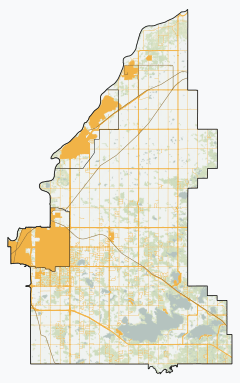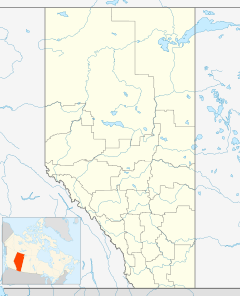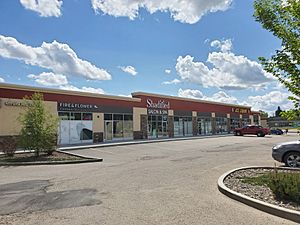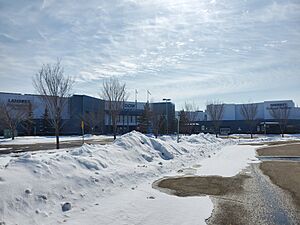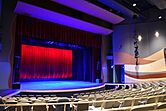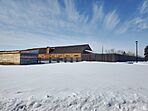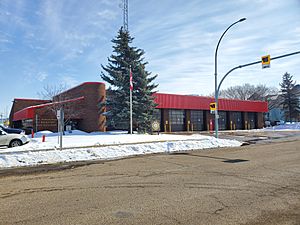Fort Saskatchewan facts for kids
Quick facts for kids
Fort Saskatchewan
|
|||
|---|---|---|---|
|
City
|
|||
| City of Fort Saskatchewan | |||
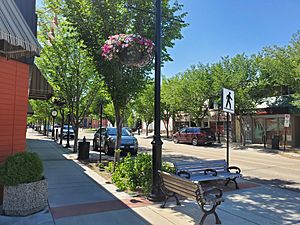
Downtown Fort Saskatchewan
|
|||
|
|||
| Motto(s):
Gotta Love It!
|
|||
| Country | Canada | ||
| Province | Alberta | ||
| Region | Edmonton Metropolitan Region | ||
| Planning region | North Saskatchewan | ||
| Adjacent Specialized municipality | Strathcona County | ||
| Adjacent municipal district | Sturgeon County | ||
| Incorporated | |||
| • Village | March 1, 1899 | ||
| • Town | July 1, 1904 | ||
| • City | July 1, 1985 | ||
| Named for | North Saskatchewan River | ||
| Area
(2021)
|
|||
| • Land | 56.5 km2 (21.8 sq mi) | ||
| Elevation | 610 m (2,000 ft) | ||
| Population
(2021)
|
|||
| • Total | 27,464 | ||
| • Density | 479.4/km2 (1,242/sq mi) | ||
| • Municipal census (2023) | 28,624 | ||
| Time zone | UTC−7 (MST) | ||
| • Summer (DST) | UTC−6 (MDT) | ||
| Forward sortation area |
T8L
|
||
| Area codes | 780, 587, 825, 368 | ||
| Highways | Highway 15, Highway 21 | ||
| Waterways | North Saskatchewan River Pointe-aux-Pins Creek Ross Creek |
||
| Public Transit Service | Fort Sask Transit | ||
Fort Saskatchewan is a city in Alberta, Canada. It is located along the North Saskatchewan River, about 25 kilometers (15 miles) northeast of Edmonton, which is the capital city of Alberta. Fort Saskatchewan is part of the larger Edmonton Metropolitan Region Board. In 2021, about 27,464 people lived here.
The city started as a North-West Mounted Police fort. It was also home to a large provincial jail for many years. Today, you can visit a replica of the original fort near where it first stood. Fort Saskatchewan is surrounded by other areas like Strathcona County and Sturgeon County.
Fort Saskatchewan is well-known for its nearby chemical plants. Big companies like Dow Chemical and Shell Canada have operations here. The city is also famous for its special flock of 50 sheep. These sheep roam around the Fort Heritage Precinct during summer, helping to keep the grass trimmed!
Contents
History of Fort Saskatchewan
How Fort Saskatchewan Started
In 1875, a group called the North-West Mounted Police (NWMP) built a fort on the North Saskatchewan River. This fort was the beginning of Fort Saskatchewan. Over the years, the community grew. It became a village in 1899, then a town in 1904, and finally a city in 1985.
The Canadian Northern Railway arrived in Fort Saskatchewan in 1905. This connected the town to a major train line across Canada. Around the same time, the first bridge was built across the river. Before the bridge, people had to use a ferry to cross. After the railway came, the town's population almost doubled.
The Old Jail
A new provincial jail opened in 1915. It replaced a smaller guard house that had been used since 1875. Over the next 70 years, the jail got bigger with more cell blocks. By 1973, it employed 220 people and held both male and female prisoners. A new correctional center replaced the old jail in 1988. Most of the old jail buildings were taken down in 1994. Only one building and the Warden's House are still standing today.
Growth with Industry
In 1952, a company called Sherritt Gordon Mines began building a large nickel refinery in Fort Saskatchewan. It started making products in 1954. After Sherritt Gordon came, more industries built plants in the town. This caused the town's population to double between 1951 and 1956.
Another big company, Dow Chemical, opened its plant in 1961. This led to another big jump in population. Fort Saskatchewan has had 29 different mayors since it became a town in 1904.
Geography and Climate
Weather in Fort Saskatchewan
Fort Saskatchewan experiences a wide range of weather throughout the year. Summers are generally warm, while winters are very cold. The city gets a good amount of rain in the summer months and snow in the winter.
| Climate data for Fort Saskatchewan | |||||||||||||
|---|---|---|---|---|---|---|---|---|---|---|---|---|---|
| Month | Jan | Feb | Mar | Apr | May | Jun | Jul | Aug | Sep | Oct | Nov | Dec | Year |
| Record high °C (°F) | 10.0 (50.0) |
15.0 (59.0) |
18.9 (66.0) |
31.1 (88.0) |
33.5 (92.3) |
33.4 (92.1) |
36.5 (97.7) |
36.0 (96.8) |
33.3 (91.9) |
29.5 (85.1) |
19.0 (66.2) |
12.5 (54.5) |
36.5 (97.7) |
| Mean daily maximum °C (°F) | −6.5 (20.3) |
−3.6 (25.5) |
1.7 (35.1) |
11.3 (52.3) |
17.9 (64.2) |
21.2 (70.2) |
23.3 (73.9) |
22.4 (72.3) |
17.2 (63.0) |
10.3 (50.5) |
−0.4 (31.3) |
−5.1 (22.8) |
9.1 (48.4) |
| Daily mean °C (°F) | −11.9 (10.6) |
−9.3 (15.3) |
−3.7 (25.3) |
4.9 (40.8) |
11.1 (52.0) |
15.0 (59.0) |
17.1 (62.8) |
15.9 (60.6) |
10.9 (51.6) |
4.4 (39.9) |
−5.3 (22.5) |
−10.4 (13.3) |
3.2 (37.8) |
| Mean daily minimum °C (°F) | −17.3 (0.9) |
−15.0 (5.0) |
−9.0 (15.8) |
−1.5 (29.3) |
4.3 (39.7) |
8.8 (47.8) |
10.8 (51.4) |
9.4 (48.9) |
4.5 (40.1) |
−1.6 (29.1) |
−10.2 (13.6) |
−15.7 (3.7) |
−2.7 (27.1) |
| Record low °C (°F) | −45.0 (−49.0) |
−41.5 (−42.7) |
−45.6 (−50.1) |
−28.0 (−18.4) |
−9.5 (14.9) |
−3.3 (26.1) |
0.5 (32.9) |
−1.0 (30.2) |
−10.0 (14.0) |
−24.5 (−12.1) |
−38.5 (−37.3) |
−43.9 (−47.0) |
−45.6 (−50.1) |
| Average precipitation mm (inches) | 24.0 (0.94) |
12.4 (0.49) |
18.7 (0.74) |
24.3 (0.96) |
43.1 (1.70) |
80.0 (3.15) |
92.0 (3.62) |
55.4 (2.18) |
40.8 (1.61) |
20.6 (0.81) |
23.3 (0.92) |
20.2 (0.80) |
454.6 (17.90) |
| Average rainfall mm (inches) | 0.6 (0.02) |
0.8 (0.03) |
0.5 (0.02) |
16.2 (0.64) |
41.1 (1.62) |
80.0 (3.15) |
92.0 (3.62) |
55.4 (2.18) |
40.8 (1.61) |
14.3 (0.56) |
2.8 (0.11) |
0.7 (0.03) |
345.2 (13.59) |
| Average snowfall cm (inches) | 23.4 (9.2) |
11.6 (4.6) |
18.1 (7.1) |
8.1 (3.2) |
2.0 (0.8) |
0.0 (0.0) |
0.0 (0.0) |
0.0 (0.0) |
0.0 (0.0) |
6.3 (2.5) |
20.5 (8.1) |
19.8 (7.8) |
109.7 (43.2) |
| Average precipitation days (≥ 0.2 mm) | 6.6 | 5 | 4.3 | 6.3 | 10.2 | 13.3 | 14.2 | 13.5 | 10.2 | 6.8 | 6.4 | 5.9 | 102.6 |
| Average rainy days (≥ 0.2 mm) | 0.14 | 0.21 | 0.66 | 5.1 | 10.1 | 13.3 | 14.2 | 13.5 | 10.2 | 6 | 1.5 | 0.18 | 75 |
| Average snowy days (≥ 0.2 cm) | 6.5 | 4.8 | 3.7 | 1.5 | 0.35 | 0 | 0 | 0 | 0.07 | 1 | 4.9 | 5.8 | 28.6 |
| Source 1: Environment Canada | |||||||||||||
| Source 2: Precipitation Days Only | |||||||||||||
People of Fort Saskatchewan
Population Growth
| Fort Saskatchewan's Population History |
||
|---|---|---|
| Year | Pop. | ±% |
| 1901 | 306 | — |
| 1906 | 585 | +91.2% |
| 1911 | 782 | +33.7% |
| 1916 | 993 | +27.0% |
| 1921 | 982 | −1.1% |
| 1926 | 943 | −4.0% |
| 1931 | 1,001 | +6.2% |
| 1936 | 899 | −10.2% |
| 1941 | 903 | +0.4% |
| 1946 | 921 | +2.0% |
| 1951 | 1,076 | +16.8% |
| 1956 | 2,582 | +140.0% |
| 1961 | 2,972 | +15.1% |
| 1966 | 4,152 | +39.7% |
| 1971 | 5,726 | +37.9% |
| 1976 | 8,304 | +45.0% |
| 1981 | 12,169 | +46.5% |
| 1986 | 11,983 | −1.5% |
| 1991 | 12,078 | +0.8% |
| 1996 | 12,408 | +2.7% |
| 2001 | 13,121 | +5.7% |
| 2006 | 14,957 | +14.0% |
| 2011 | 19,051 | +27.4% |
| 2016 | 24,149 | +26.8% |
| 2021 | 27,464 | +13.7% |
| Sources: Statistics Canada and City of Fort Saskatchewan |
||
In 2021, the population of Fort Saskatchewan was 27,464 people. This was a 13.6% increase from 2016, when the population was 24,169. The city continues to grow. In 2023, a local count showed the population reached 28,624.
Jobs and Education
Many people in Fort Saskatchewan work in trades, transport, and equipment operation. Sales and service jobs are also common, as are business and finance roles. Most adults in the city have a post-secondary certificate, diploma, or degree. Many also have a high school diploma or a college certificate.
Diverse Community
Fort Saskatchewan is home to people from many different backgrounds. In 2016, the largest groups of visible minorities were from the Philippines and South Asia. Many residents also identify as Indigenous, including First Nations and Métis people.
Economy and Shopping
Fort Saskatchewan's economy is mainly based on industry and business. It is part of Alberta's Industrial Heartland, which is a very large industrial area in Canada. Companies like Dow Chemical and Shell Canada are major employers here. These plants provide many jobs for people living in and around the city.
The city also has many big stores. You can find places like Wal-Mart, The Home Depot, and Canadian Tire. Fort Saskatchewan is a shopping center for people from nearby towns too. In 2019, it served about 75,000 people from the city and surrounding communities.
Fort Station Mall
The Fort Station Mall is a major shopping area. It was redeveloped starting in 2015. Many of the old mall buildings were replaced with new stores that face outwards. There are plans to add more shops and even apartments in the future.
Fun Things to Do
Sports and Recreation
The Dow Centennial Centre is a big place for sports and culture in Fort Saskatchewan. It has an ice arena, a gym, a field house, and a fitness center. It also has a theater for shows, an art gallery, and a banquet hall.
The city has two other indoor ice arenas, the Jubilee Recreation Centre and the Sportsplex. These are used for hockey, ringette, and figure skating in winter. In summer, they are used for lacrosse. Fort Saskatchewan also has Harbour Pool, an indoor swimming pool with a slide. A new artificial turf field for soccer and football, called Taurus Field, opened in 2018. It has seating for over 1000 people.
There is a nine-hole golf course and a curling club in the city. You can also launch a boat into the North Saskatchewan River at Red Coat Landing. Elk Island National Park is a short drive away.
Trails for Exploring
Fort Saskatchewan has more than 75 kilometers (47 miles) of paved trails. About 20 kilometers (12 miles) of these trails are along the river valley and in city parks. A new pedestrian bridge is being built across the North Saskatchewan River. This bridge will connect Fort Saskatchewan's trails to those in Sturgeon County. These trails are part of the larger Trans Canada Trail network.
Culture and History
The Fort Heritage Precinct is a museum and historic site. It covers 11 hectares (27 acres) and has many old buildings that form a historical village. You can explore a full-size replica of the original NWMP fort with guided tours. This replica fort opened in 2011. It includes the Men's Quarters, Officers' Quarters, a horse stable, and jail cells.
The replica fort was built next to the original fort's site. Wooden markers show where the original fort's walls and gates once stood.
Every May, the historical society hosts an event called "The Peoples of the North Saskatchewan." It teaches students about Métis and settler cultures. The city keeps a flock of sheep at the Heritage Precinct every summer. They help cut the grass, and visitors can interact with them. The city's mascot, Auggie, is a sheep. This is a nod to Fort Augustus, an old trading post nearby.
Fort Saskatchewan has a public library located in the same building as City Hall. There is also a local theater group called The Sheeptown Players Drama Society. They perform plays for the community.
Sports Teams
The Pyramid Corp. Hawks, a junior hockey team, play at the Jubilee Recreation Centre. Another junior hockey team, the Fort Saskatchewan Traders, moved to St. Albert in 2007.
Fort Saskatchewan is also home to the Heartland Roller Derby Association, a roller derby league started in 2016. There are youth sports groups for hockey, soccer, baseball, ringette, lacrosse, and figure skating. There are also groups for cross-country skiing and swimming.
City Services
Emergency Services
Fire Department
The Fort Saskatchewan Fire Department started in 1906. It has 12 full-time firefighters and many paid volunteers. Full-time firefighters work shifts, ensuring someone is always at the station. This change in 2020 greatly reduced how long it takes for firefighters to respond to emergencies.
The city bought land for a second fire station in 2017. This is because the city is growing, and more calls are coming from newer neighborhoods. Fort Saskatchewan was also home to Canada's longest-serving firefighter, Walter Thomas. He served from 1947 until he passed away in 2017.
Public Transportation
Fort Sask Transit (FST) runs two bus routes daily within the city. For longer trips, Fort Saskatchewan works with Strathcona County Transit. This service provides bus rides between Fort Saskatchewan and Sherwood Park during busy hours. All FST buses are accessible for people with mobility issues. There is also a special minivan service for people with physical disabilities who cannot use regular transit.
Utilities and Waste
Fort Saskatchewan gets its water from the Capital Region Northeast Water Services Commission. This commission buys treated water from EPCOR, which gets it from the North Saskatchewan River. Wastewater is treated at a facility in Strathcona County.
The city has a system for managing household waste. Residents separate their waste into three types: organic waste (green bins), general garbage (black bins), and recycling (blue bags). This system started in 2018. Garbage is collected every two weeks, organics are collected weekly or bi-weekly, and recycling is collected weekly.
Education in Fort Saskatchewan
Fort Saskatchewan does not have its own public universities or colleges. However, the local corrections center partners with NorQuest College. This partnership offers courses and job training to inmates. Most residents who want to go to college or university travel to Edmonton. They attend places like the University of Alberta or MacEwan University.
Schools in Fort Saskatchewan are managed by two different school boards: Elk Island Public Schools and Elk Island Catholic Schools.
Local Media
Fort Saskatchewan has two local newspapers. The Fort Saskatchewan Record is delivered weekly on Thursdays. The Sturgeon Creek Post is a weekly newspaper available at local businesses. Larger newspapers like the Edmonton Journal are also available.
The city has one local radio station, Mix 107.9 FM. It broadcasts live and is owned by Kenner Media Ltd.
Images for kids
See also
 In Spanish: Fort Saskatchewan para niños
In Spanish: Fort Saskatchewan para niños



